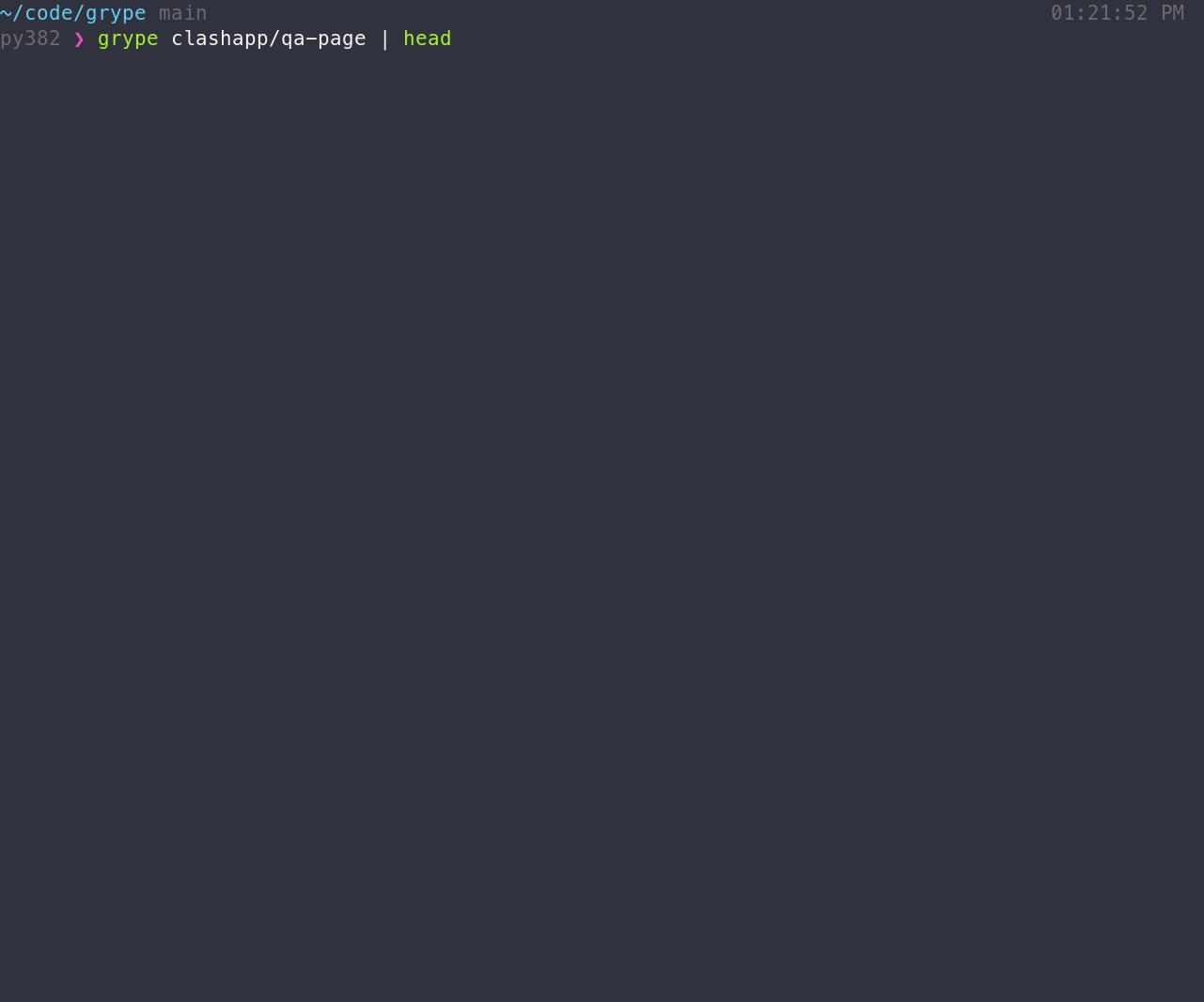* add fix-in-version to the json and table presenters Signed-off-by: Alex Goodman <alex.goodman@anchore.com> * incorporate grype-db fixed-in updates Signed-off-by: Alex Goodman <alex.goodman@anchore.com> |
||
|---|---|---|
| .circleci | ||
| .github | ||
| cmd | ||
| grype | ||
| internal | ||
| resources | ||
| test | ||
| ui | ||
| .bouncer.yaml | ||
| .gitignore | ||
| .golangci.yaml | ||
| .goreleaser.yaml | ||
| CONTRIBUTING.md | ||
| go.mod | ||
| go.sum | ||
| install.sh | ||
| LICENSE | ||
| main.go | ||
| Makefile | ||
| README.md | ||
grype
A vulnerability scanner for container images and filesystems. Easily install the binary to try it out.
Features
- Scan the contents of a container image or filesystem to find known vulnerabilities.
- Find vulnerabilities for major operating system packages
- Alpine
- BusyBox
- CentOS / Red Hat
- Debian
- Ubuntu
- Find vulnerabilities for language-specific packages
- Ruby (Bundler)
- Java (JARs, etc)
- JavaScript (NPM/Yarn)
- Python (Egg/Wheel)
- Python pip/requirements.txt/setup.py listings
⚠️ This is pre-release software and it may not work as expected. If you encounter an issue, please let us know using the issue tracker.
Getting started
Install the binary, and make sure that grype is available in your path. To scan for vulnerabilities in an image:
grype <image>
The above command scans for vulnerabilities that are visible in the container (i.e., the squashed representation of the image).
To include software from all image layers in the vulnerability scan, regardless of its presence in the final image, provide --scope all-layers:
grype <image> --scope all-layers
Grype can scan a variety of sources beyond those found in Docker.
# scan a docker image tar (from the result of "docker image save ... -o image.tar" command)
grype docker-archive://path/to/image.tar
# scan a directory
grype dir://path/to/dir
By default Grype shows a summary table, however, a more detailed json format is also available.
grype <image> -o json
Grype pulls a database of vulnerabilities derived from the publicly available Anchore Feed Service. This database is updated at the beginning of each scan, but an update can also be triggered manually.
grype db update
Installation
Recommended
# install the latest version to /usr/local/bin
curl -sSfL https://raw.githubusercontent.com/anchore/grype/main/install.sh | sh -s -- -b /usr/local/bin
# install a specific version into a specific dir
curl -sSfL https://raw.githubusercontent.com/anchore/grype/main/install.sh | sh -s <RELEASE_VERSION> -b <SOME_BIN_PATH>
macOS
brew tap anchore/grype
brew install grype
You may experience a "macOS cannot verify app is free from malware" error upon running Grype because it is not yet signed and notarized. You can override this using xattr.
xattr -rd com.apple.quarantine grype
Configuration
Configuration search paths:
.grype.yaml.grype/config.yaml~/.grype.yaml<XDG_CONFIG_HOME>/grype/config.yaml
Configuration options (example values are the default):
# same as -o ; the output format of the vulnerability report (options: table, json)
output: "table"
# same as -s ; the search space to look for packages (options: all-layers, squashed)
scope: "squashed"
# same as -q ; suppress all output (except for the vulnerability list)
quiet: false
log:
# use structured logging
structured: false
# the log level; note: detailed logging suppress the ETUI
level: "error"
# location to write the log file (default is not to have a log file)
file: ""
# enable/disable checking for application updates on startup
check-for-app-update: true
db:
# location to write the vulnerability database cache
cache-dir: "$XDG_CACHE_HOME/grype/db"
# URL of the vulnerability database
update-url: "https://toolbox-data.anchore.io/grype/databases/listing.json"
# check for database updates on execution
auto-update: true
Developing
There are a few useful things to know before diving into the codebase. This project depends on a few things being available like a vulnerability database, which you might want to create manually instead of retrieving a released version.
Inspecting the database
The currently supported database provider is Sqlite3. Install sqlite3 in your system and ensure that the sqlite3 executable is available in your path. Ask grype about the location of the database, which will be different depending on the operating system:
$ go run main.go db status
Location: /Users/alfredo/Library/Caches/grype/db
Built: 2020-07-31 08:18:29 +0000 UTC
Current DB Version: 1
Require DB Version: 1
Status: Valid
In this case (OSX), the database is located in the user's home directory. To verify the database filename, list that path:
$ ls -alh /Users/alfredo/Library/Caches/grype/db
total 445392
drwxr-xr-x 4 alfredo staff 128B Jul 31 09:27 .
drwxr-xr-x 3 alfredo staff 96B Jul 31 09:27 ..
-rw------- 1 alfredo staff 139B Jul 31 09:27 metadata.json
-rw-r--r-- 1 alfredo staff 217M Jul 31 09:27 vulnerability.db
Next, open the vulnerability.db with sqlite3:
$ sqlite3 /Users/alfredo/Library/Caches/grype/db/vulnerability.db
To make the reporting from Sqlite3 easier to read, enable the following:
sqlite> .mode column
sqlite> .headers on
List the tables:
sqlite> .tables
id vulnerability vulnerability_metadata
In this example you retrieve a specific vulnerability from the nvd namespace:
sqlite> select * from vulnerability where (namespace="nvd" and package_name="libvncserver") limit 1;
id record_source package_name namespace version_constraint version_format cpes proxy_vulnerabilities
------------- ------------- ------------ ---------- ------------------ -------------- ----------------------------------------------------------- ---------------------
CVE-2006-2450 libvncserver nvd = 0.7.1 unknown ["cpe:2.3:a:libvncserver:libvncserver:0.7.1:*:*:*:*:*:*:*"] []
Future plans
The following areas of potential development are currently being investigated:
- Add CycloneDX to list of output formats
- Support for allowlist, package mapping
- Establish a stable interchange format w/Syft
- Accept SBOM (CycloneDX, Syft) as input instead of image/directory


